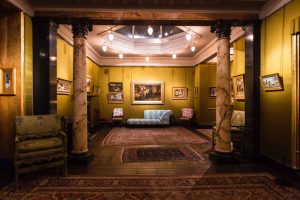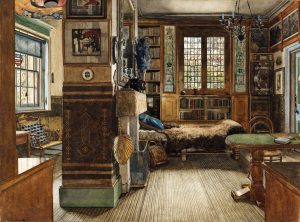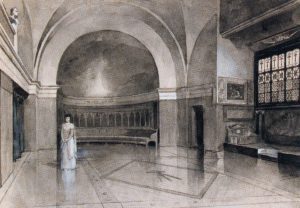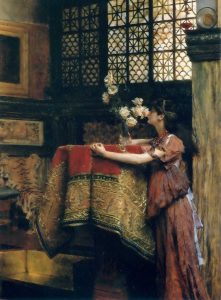Lawrence Alma-Tadema: At Home in Antiquity
Home Subjects was delighted to attend a recent conference at the Paul Mellon Centre for Studies in British Art in London that will surely be of interest to our readers: “Alma-Tadema: Antiquity at Home and On Screen.” The symposium coincided with the appearance of an exhibition of Sir Lawrence Alma-Tadema’s work at Leighton House Museum entitled “Lawrence Alma Tadema: At Home in Antiquity.” Organized by Peter Trippi, Elizabeth Prettejohn, and Ivo Blom, the exhibition appeared at the Fries Museum in Leeuwarden, The Netherlands (the artist’s hometown), followed by the Belvedere in Vienna, and then finally Leighton House Museum. Alas for readers of this post, the last day was Sunday, October 29. But the research presented at the symposium suggested the range of exciting new work on the artist and the idea of the artist’s studio-house.

Installation of the exhibition “Alma-Tadema At Home in Antiquity” at Leighton House Museum. Photograph by Kevin Moran.
This post is the first in a series that will consider the research presented by the exhibition, the accompanying publication, and the speakers at the symposium. That event was organized by a team that included Elizabeth Prettejohn, Peter Trippi, Sarah Victoria Turner (of the Paul Mellon Centre), and Maria Wyke (Professor of Latin, UCL), and Ian Christie (Professor of Film and Media History, Birkbeck, University of London). Each day of the two-day event addressed different themes in Alma-Tadema’s art: day one considered the studio houses, including those of Alma-Tadema and other artists (especially Leighton House), studio-houses abroad, and the cultural life of the extended Tadema family. For many visitors, even those familiar with Alma-Tademas art, the surprise of the exhibition was the artistic output of his wife Laura Alma-Tadema and his daughter Anna. The second day address films set in classical antiquity, including the influence of Tadema’s paintings on depictions of life in the ancient world in other media, such as tableaux vivants, theater, and film. The Paul Mellon Centre has provided recordings of the talks on the first day, including plenary lectures by Christopher Reed and Mary Roberts.
Leighton House Museum was a fitting venue for an exhibition that explored the range of meanings that attached to domestic life in the art of Alma-Tadema (1836-1912). Many of the subjects of this “Victorian classicist” addressed domestic life in antiquity. Perhaps less well-known to audiences is the extent to which Alma-Tadema also orchestrated his own domestic and working life in two studio-houses he created in St. John’s Wood, with his wife Laura (also an artist) and his daughters Laurence and Anna, who was also an artist.

Anna Alma-Tadema, “Sir Lawrence Alma-Tadema’s Study in Townshend House, London, 1884, Thaw Collection, Cooper-Hewitt, Smithsonian Design Museum, New York.
The first studio-house was Townshend House (North Gate, Regent’s Park; the family lived there from 1871-5. Anna Alma-Tadema created a series of watercolor of the house, including a view of the study, that suggests the wide range of artistic interests and inspiration, including what Charlotte Gere has identified in the exhibition catalogue as a dado of resist-dyed cotton from the Dutch East Indies. In 1883, the artist acquired a new house, one that had originally been enlarged by the artist James Tissot. He set about extensively remodeling the house and gardens, adding such practical features as a changing room and washing facilities for models. And it was at Grove End House that Alma-Tadema set about creating “Casa Tadema,” an architecturally sophisticated space adorned with the artist’s collection of antiques and curios.

Nicolaas van der Waay, “Lawrence Alma-Tadema’s Studio at 17, Grove End Road, c. 1891. Fries Museum, Leeuwarden.
As Charlotte Gere remarks in the exhibition catalogue, “Tadema’s Roman-style villa was an elaborate example of late Victorian neoclassicism, though decoratively it was more eclectic. His study of Pompeian archaeology inspired the entrance, cast from the door-frame of the House of Eumachia. A solid brass staircase led form the entrance to the studio. ‘Persian’ tiles from Naples . . . adorned the hall, there as an inmpluvium with a marble fountain, and an aluminium semi-dome in the studio. The studio’s resemblance to a Byzantine church was much remarked,” as suggested by the watercolor by Nicolaas van der Waay, a Dutch artist who visited Alma-Tadema in London in the early 1890s. van der Waay’s almost monochromatic accounts of the space provide it with a kind of ancient austerity that was often lacking from the space, also visible in Alma-Tadema’s painting In My Studio, at the top of this post. In the later painting, the same window, with its distinctive iron grille, is visible, but it is now the backdrop to a scene of lush sensuality, as the feel of the tiger skin rug, the scent of the roses, and the sounds of the piano (partially hidden underneath the elaborate gold and red covering) are all evoked. Impressively, the exhibition’s curators and designer were able to invoke this space within the physical space of Leighton’s own studio.
The installation at Leighton House did not allow one artist (Alma-Tadema) to overtake the other (Leighton). Rather, it created a dialogue between the work and the life of each. It is this kind of associative property of the artist’s studio that Theodor Adorno highlights in his essay “Valery, Proust, Museum.” The studio is the place of art’s immediacy, where it is protected for the “barbarity” of the museum. Future posts will feature further reflection on these topics.
